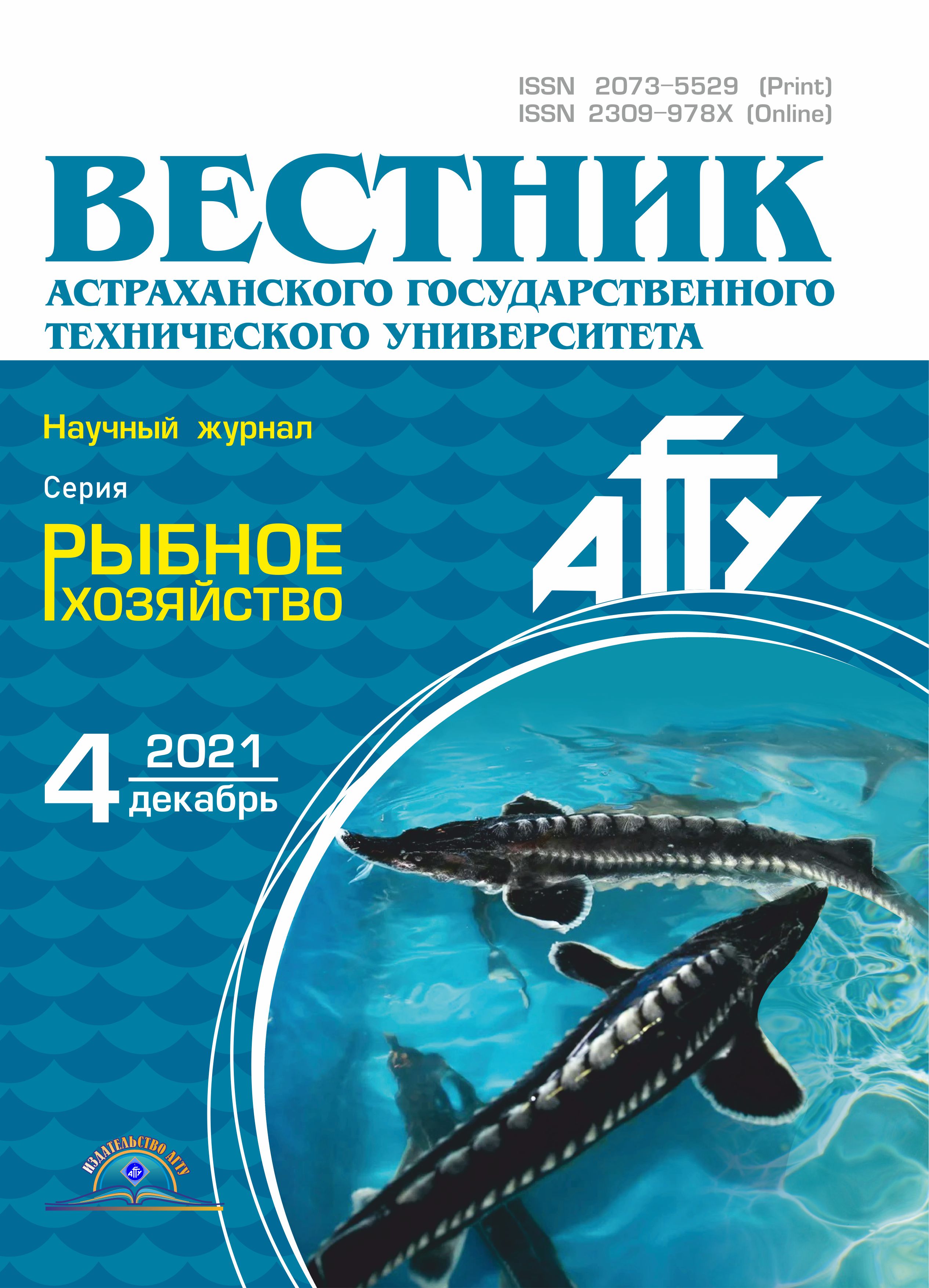The study was carried out on the basis of the analysis of poaching sturgeon species in the lower reaches of the Irtysh River (the Tyumen region and Khanty-Mansi Autonomous Okrug), according to the results of forensic ichthyologic examinations over the period from 2013 to 2020. The size and weight ratio of Siberian sturgeon and sterlet in catches, the average weight of one fish species, the number of examinations performed, as well as the dynamics of these indicators for the considered time period were evaluated. As a result of the analysis performed, there has been seen an upward trend in the number of expert examinations (from 10 in 2013 to 25 in 2020). Among sturgeon species sterlet dominates in size, with the exception the period of 2017-2018. There has been stated the dynamics of increasing mass of Siberian sturgeon and, accordingly, a decrease for sterlet, with the average share of sturgeon to be less 50%. The average mass of a Siberian sturgeon species has increased from 0.8 to 1.2 kg, as well as a positive trend for the above period is noted when analyzing the total mass of sturgeon species during yearly examinations. Body mass of poached sterlet species hasn’t increased over the 8-year period, and its average value made 0.11–0.13 kg. Over the investigated period the number of forensic ichthyologic examinations has increased, the average mass growth dynamics in a Siberian sturgeon species has been stated, with predominating of immature species in both of sterlet and Siberian sturgeon catches.
ichthyologic examination, Siberian sturgeon, sterlet, quantity, mass, the Irtysh River, the Ob-Irtysh basin
1. Dgebuadze Y. Y. Fishery and freshwater ecosystems of Russia // Freshwater Fisheries Ecology. 2015. 12 September. P. 120-133. https://doi.org/10.1002/9781118394380.ch9.
2. Davis T. R., Harasti D. Predictive modelling of illegal fishing in no-take marine protected areas // Fisheries Management and Ecology. 2020. N. 27 (3). P. 292-301. https://doi.org/10.1111/fme.12412.
3. Vince J., Hardesty B. D., Wilcox C. Progress and challenges in eliminating illegal fishing // Fish and Fisheries. 2021. N. 22. P. 518- 531. https://doi.org/10.1111/faf.12532.
4. Barabanov V. V., Tkach V. N., Shipulin S. V. Opyt ocenki neuchtennogo iz'yatiya poluprohodnyh i rechnyh vidov ryb v Astrahanskoy oblasti // Vestn. Astrahan. gos. tehn. un-ta. Ser.: Rybnoe hozyaystvo. 2017. № 2. S. 18-25. https://doi.org/10.24143/2073-5529-2017-2-18-25.
5. Mirrasooli E., Ghorbani R., Gorgin S., Aghilinejhad S. M., Jalali A. Factors associated with illegal fishing and fisher attitudes toward sturgeon conservation in the southern Caspian Sea // Marine Policy. 2019. N. 100. P. 107-115. https://doi.org/10.1016/j.marpol.2018.11.028.
6. Haque A. B., D’Costa N. G., Washim M., Baroi A. R., Hossain N., Hafiz M., Rahman S., Biswas K. F. Fishing and trade of devil rays (Mobula spp.) in the Bay of Bengal, Bangladesh: Insights from fishers’ knowledge // Aquatic Conservation: Marine and Freshwater Ecosystems. 2020. N. 31 (6). P. 1392-1409. https://doi.org/10.1002/aqc.3495.
7. Magqina T., Nhiwatiwa T., Dalu M. T. B., Mhlanga L., Dalu T. Challenges and possible impacts of artisanal and recreational fisheries on tigerfish Hydrocynus vittatus Castelnau 1861 populations in Lake Kariba, Zimbabwe // Scientific African. 2020. N. 10. e00613. https://doi.org/10.1016/j.sciaf.2020.e00613.
8. Aceves-Bueno E., Read A. J., Cisneros-Mata M. A. Illegal fisheries, environmental crime, and the conserva-tion of marine resources // Conservation Biology. 2021. N. 35 (4). P. 1120-1129. doihttps://doi.org/10.1111/cobi.13674.
9. Zhuang W., Liu M., Gao Z. A new method for quantifying the value of ecological environment damage caused by illegal fishing: A case study // Marine Pollution Bulletin. 2021. N. 172. 112819. https://doi.org/10.1016/j.marpolbul.2021.112819.
10. Rodríguez-García O. U., Seijo J. C., De Anda-Montañez J. A., Villanueva R. Recovery timelines of vulnerable high value species under moratoria: Dealing with uncertain levels of illegal fishing // Fisheries Re-search. 2019. N. 220. 105345. https://doi.org/10.1016/j.fishres.2019.105345.
11. Aghilinejhad S. M., Gorgin S., van Uhm D., Joolaie R., Ghorbani R., Paighambari S. Y., Mohammadi J., Jalali A. What are the drivers of the occurrence of illegal fishing and conservation barriers of sturgeons in the Caspian Sea? // Aquatic Conservation: Marine and Freshwater Ecosystems. 2018. N. 28 (3). P. 690-701. https://doi.org/10.1002/aqc.2897.
12. Ludwig A. Identification of Acipenseriformes species in trade // Journal of Applied Ichthyology. 2008. N. 24 (s1). P. 2-19. https://doi.org/10.1111/j.1439-0426.2008.01085.x.
13. Vilkova O. Yu., Glubokovskiy M. K. Sohranenie osetrovyh ryb Kaspiya: mezhdunarodnoe sotrudnichestvo // Tr. VNIRO. 2018. № 174. S. 112-128.
14. Prokop'eva N. Yu. K voprosu o sostoyanii obskoy populyacii sibirskogo osetra // Perspektivy razvitiya sovremennyh sel'skohozyaystvennyh nauk: sb. nauch. tr. po itogam Mezhdunar. nauch.-prakt. konf. (Voronezh, 11 dekabrya 2016 g.). N. Novgorod: Innovac. centr razvitiya obrazovaniya i nauki, 2016. S. 26-30.
15. Krasnaya kniga Tyumenskoy oblasti: Zhivotnye, rasteniya, griby. / otv. red. O. A. Petrova. Kemerovo: OOO «Tehnoprint», 2020. 460 s.
16. Pravdin I. F. Rukovodstvo po izucheniyu ryb (preimuschestvenno presnovodnyh) / pod red. prof. P. A. Dryagina i kand. biol. nauk V. V. Pokrovskogo. M.: Pisch. prom-st', 1966. 376 s.
17. Nikol'skiy G. V. Chastnaya ihtiologiya. M.: Vyssh. shk., 1971. 471 s.
18. Atlas presnovodnyh ryb Rossii: v 2 t. / pod red. Yu. S. Reshetnikova. M.: Nauka, 2002. T. 1. 379 s.
19. Weekers D., Petrossian G., Thiault L. Illegal fishing and compliance management in marine protected areas: a situational approach // CrimRxiv. 2021. May 17. https://doi.org/10.21428/cb6ab371.c83eed16.
















